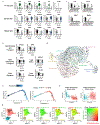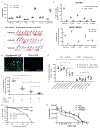TREM2 macrophages induced by human lipids drive inflammation in acne lesions
- PMID: 35867799
- PMCID: PMC9400695
- DOI: 10.1126/sciimmunol.abo2787
TREM2 macrophages induced by human lipids drive inflammation in acne lesions
Abstract
Acne affects 1 in 10 people globally, often resulting in disfigurement. The disease involves excess production of lipids, particularly squalene, increased growth of Cutibacterium acnes, and a host inflammatory response with foamy macrophages. By combining single-cell and spatial RNA sequencing as well as ultrahigh-resolution Seq-Scope analyses of early acne lesions on back skin, we identified TREM2 macrophages expressing lipid metabolism and proinflammatory gene programs in proximity to hair follicle epithelium expressing squalene epoxidase. We established that the addition of squalene induced differentiation of TREM2 macrophages in vitro, which were unable to kill C. acnes. The addition of squalene to macrophages inhibited induction of oxidative enzymes and scavenged oxygen free radicals, providing an explanation for the efficacy of topical benzoyl peroxide in the clinical treatment of acne. The present work has elucidated the mechanisms by which TREM2 macrophages and unsaturated lipids, similar to their involvement in atherosclerosis, may contribute to the pathogenesis of acne.
Conflict of interest statement
Figures





References
-
- Hay RJ et al., The global burden of skin disease in 2010: an analysis of the prevalence and impact of skin conditions. J. Invest. Dermatol 134, 1527–1534 (2014). - PubMed
-
- Fried RG, Acne vulgaris: The psychosocial and psychological burden of llness. The Dermatologist 21, 28–32 (2013).
-
- Zaraa I et al., Severity of acne and its impact on quality of life. Skinmed 11, 148–153 (2013). - PubMed
-
- Mooney T, Preventing psychological distress in patients with acne. Nurs. Stand 28, 42–48 (2014). - PubMed
-
- Aktan S, Ozmen E, Sanli B, Anxiety, depression, and nature of acne vulgaris in adolescents. Int. J. Dermatol 39, 354–357 (2000). - PubMed
Publication types
MeSH terms
Substances
Grants and funding
- T32 GM008042/GM/NIGMS NIH HHS/United States
- P30 AR075043/AR/NIAMS NIH HHS/United States
- P30 DK056341/DK/NIDDK NIH HHS/United States
- K01 AG061236/AG/NIA NIH HHS/United States
- UG3 CA268091/CA/NCI NIH HHS/United States
- R01 AR073252/AR/NIAMS NIH HHS/United States
- R01 AR075959/AR/NIAMS NIH HHS/United States
- P50 AR080594/AR/NIAMS NIH HHS/United States
- R01 CA245277/CA/NCI NIH HHS/United States
- T32 AG000114/AG/NIA NIH HHS/United States
- R01 AI022553/AI/NIAID NIH HHS/United States
- R01 AR074302/AR/NIAMS NIH HHS/United States
- R01 AR040312/AR/NIAMS NIH HHS/United States
- T32 AR071307/AR/NIAMS NIH HHS/United States
LinkOut - more resources
Full Text Sources
Medical
Molecular Biology Databases

